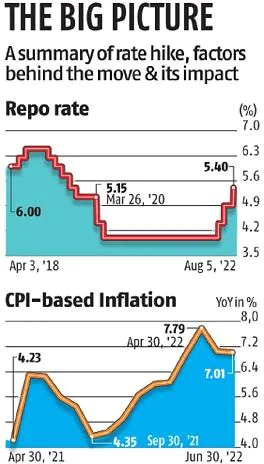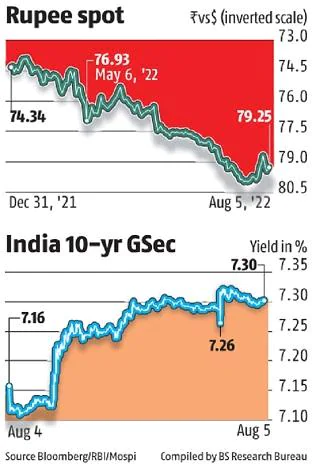RBI stays hawkish in fight against inflation; MPC reverses Covid-era cuts
The six-member Monetary Policy Committee (MPC) of the Reserve Bank of India (RBI) on Friday hiked the policy repo rate by 50 basis points to 5.4 per cent — a three-year high —owing to inflation concern and to shield the exchange rate, which has come under pressure since war broke out in Europe in February.
The home loan rates of some major lenders like State Bank of India will cross 8 per cent with this repo rate hike. The home loan rate linked to the external benchmark or the repo rate is 7.55 per cent for many lenders now.
While the six members were unanimous on the rate increase, external member Jayanth Varma dissented on the MPC’s statement “focus on withdrawal of accommodation”.
While the rate hike was at the higher end of the expectation spectrum, the hawkish tone of RBI Governor Shaktikanta Das stumped the bond market, which rallied this week in expectation of the central bank indicating that large rate hikes might not be in the offing after the August action.
The yield of the 10-year government bond, which fell 17 basis points in the past four days, ended 14 basis points higher to close at 7.30 per cent.
“We expect the RBI to continue with its rate hikes in the upcoming policies, taking rates up to 5.75 per cent by the end of the year,” said Abheek Barua, chief economist, HDFC Bank.
“The bond market rally seen over the past few days is likely to reverse and we expect the 10-year paper to trade closer to 7.3-7.4 per cent by the end of the quarter as the markets reprice the RBI’s action,” Barua said.
Terming 7 per cent CPI inflation unacceptable and unsustainable, Das said there was a need to bring it back to 4 per cent, which is the target for the MPC.
“… with growth momentum expected to be resilient despite headwinds from the external sector, monetary policy should persevere further in its stance of withdrawal of accommodation to ensure that inflation moves close to the target of 4.0 per cent over the medium term,” Das said during the post-policy interaction with the media.
The MPC stressed sustained high prices could destabilise inflation expectations and harm growth in the medium term.
“Today’s (Friday’s) 50 basis point hike is an indication that the RBI is more concerned with the rupee and external situation, i.e. using the interest rate as a defence to protect the rupee,” said Soumya Kanti Ghosh, group chief economic advisor, State Bank of India.
The central bank said liquidity in the banking system tightened at the end of July, which led to the firming up of money market rates above the repo rate.
Das said the RBI would remain vigilant on liquidity and conduct two-way fine-tuning operations as and when warranted — both variable rate repo (VRR) and variable rate reverse repo (VRRR) operations of different tenors.
On growth, the central bank sounded confident. Das pointed to improvement in urban demand while there were mixed signals on the rural side.
“Capacity utilisation in the manufacturing sector is now above its long-run average, signalling the need for fresh investment activity in additional capacity creation,” Das said while pointing to 14 per cent y-o-y bank credit growth.
While credit is expanding at a healthy pace, deposit growth has been lagging, requiring banks to make their deposits more attractive by increasing interest rates.
“When there is credit offtake, banks can sustain and support it only if they have higher deposits. They cannot be relying on central bank money on a perennial basis … For supporting credit offtake, banks will raise deposit rates and they will make efforts to mobilise more deposits,” Das said.
According to SBI Research, while the weighted average lending rates for outstanding and fresh rupee loans have gone up by 19 and 31 basis points, respectively, from March 2022, the weighted average domestic term deposit rate for outstanding deposits has moved up 10 basis points during the same time.
According to the RBI data, the incremental credit-deposit ratio has risen from 77.2 per cent at the end of March to 246.8 per cent as on June 17.


 Loan, Personal Loan, Home Loan, Business Loan,Loans in India Loan in India, Personal Loan, Home Loan, Business Loan, Loans in India,Loan Finance,Loan in India, Get Instant Personal Loan,Home Loan, Business Loans in India
Loan, Personal Loan, Home Loan, Business Loan,Loans in India Loan in India, Personal Loan, Home Loan, Business Loan, Loans in India,Loan Finance,Loan in India, Get Instant Personal Loan,Home Loan, Business Loans in India